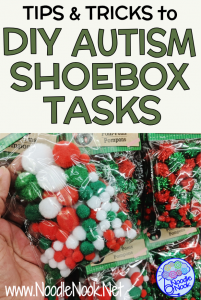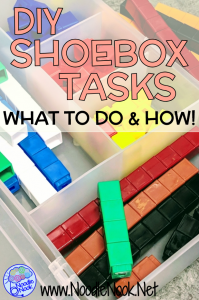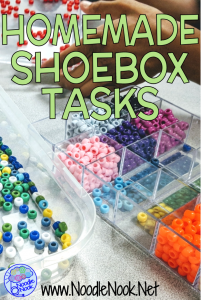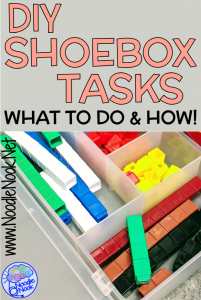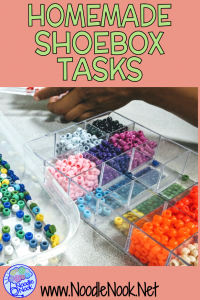Doing some DIY to create homemade shoebox tasks for Autism Units or Life Skills is a great way to set up workstation tasks on a dime. Read more on how to make homemade shoebox tasks.

Where to Start with Homemade Shoebox Tasks
If you are looking to make some homemade shoebox tasks, then you want to start with some focus… running around tossing stuff in a box and calling it a task box is a waste of your time and will probably not meet the needs of your students. Before you look around for WHAT you can use, you will have to think about WHY you need shoebox tasks.
Start with just one student and pull their current IEP. Look over skills that are mastered. Why mastered? When you build shoebox tasks for work stations, you want to work on tasks that a student can do independently. When students can work independently, you have more time to work in small groups and do some great first-time instruction. So, scan the paperwork for mastered goals. Then, look at those goals and think about underlying skills that support it.
Quick example: Student has mastered identifying numbers to 20 and their new goal is to add numbers from 1-10. The shoebox task will focus on the identification of numbers possibly from 1-10 (which is a mastered skill and reinforces prerequisite skills for addition). This task could be worked on without any support from staff in a work station.
Take a look at several students, assess their needs and goals, and see where mastered skills overlap. That would allow several students to work from the same box. Pulling double duty is awesome!
What to Snag to DIY Shoebox Tasks
So now you have some direction, what next? Here is where your inner Design on a Dime kicks in!
Start by saving small put in containers. I love yogurt cups, jello cups, and Mentos gum containers. You are looking for things that are easy to come by so you can have several of the same size. Then look around for some bigger containers too. My favorites are plastic coffee cans and medium-sized oatmeal containers. On top of being a great size, the lids are really easy to cut to make openings for objects. Finally, start hoarding shoe boxes or shoebox-sized plastic containers.
Enlist the help of parents and coworkers. When you put the word out that you need these things, you’d be surprised how fast and furious they pour in.
Now that you have gathered lots of containers, you’ll need items to go in them.
What Else to Snag for Homemade Shoebox Tasks
There are three things I think about whenever I search for items to put into a shoebox task… durability, washability, and replaceability! Truth is you can put anything into a task box, what you really need to reflect upon is the purpose of the activity. If you are working on an academic task, you’ll want something related to the student’s IEP goals and current mastered skill set.
An example may be:
In math, a student is working on counting items up to 10. With 10 little empty jello cups, an egg crate, or small baskets, I will label each with a number from one to ten and the student will count items to put in them that match the assigned number.
Another example is in reading, a student is working on recognizing their name. With two baskets or empty coffee cans labeled “My Name” and Not My Name”. I will print out several name cards with their name and then several wrongs and the student will sort the cards.
A functional goal related to their therapy goals may be just a simple put in task where the student is putting items into a container to work on fine or gross motor. For fun, I may add color differentiation to kick it up a notch.
In these three examples, other than the containers, I would need some math manipulatives (which you probably already have laying around), to print some cards, and some puff balls! I can score all this will less than a couple of bucks or with donations from parents. Honestly, I have all this in my classroom already over years of teacher-hoarding. It’s okay, it’s totally health to hoard as a teacher. Right?
Anywho, look around for things you already have and decide if it meets the durability, washability and replaceability needs of your students.
Putting it All Together
Once you have all the items gathered, put some meaningful and helpful visuals in place to tell a student what to do, when to stop, and other visuals for independence. With all that in place, you may have some students who still need some task analysis strips with step by steps for the task, especially if you want this to be in a worksystem where supervision is minimal. With those two extra pieces, you’ll make the most out of your homemade shoebox tasks and your students will reap the benefits of building independence, gaining work skills, and improving executive functioning.
What have you made for your classroom? Post it in the comments or take a picture and share it on social media… just be sure to tag #TheNoodleNook on Instagram or @_YoTeacher on Twitter. We love to see your awesomeness in action!
Article Citation: [cite]

